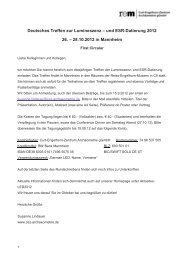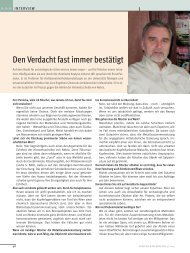Jahresbericht 2010 - Curt-Engelhorn-Zentrum Archäometrie gGmbH
Jahresbericht 2010 - Curt-Engelhorn-Zentrum Archäometrie gGmbH
Jahresbericht 2010 - Curt-Engelhorn-Zentrum Archäometrie gGmbH
Erfolgreiche ePaper selbst erstellen
Machen Sie aus Ihren PDF Publikationen ein blätterbares Flipbook mit unserer einzigartigen Google optimierten e-Paper Software.
Seite 44 <strong>Jahresbericht</strong> <strong>2010</strong><br />
Fig. 9 Fired chert. Binocular<br />
microscope, polished<br />
section<br />
chert nodules were broken<br />
away from a washed rock<br />
or, more likely, that the<br />
eroded nodules and fragments<br />
were collected in<br />
clusters in the immediate<br />
vicinity of a host rock. Metasomatic<br />
nodular chert<br />
from which Kopac ina artefacts<br />
were made may originate<br />
from an autochthonous<br />
or parautochthonous<br />
outcrop on Brac , some<br />
other island as well as the<br />
inter-island area or from<br />
the mainland side of Dalmatia<br />
and hinterland. Considering<br />
that Kopac ina<br />
hunter- gatherers did not<br />
use the numerous, abundant<br />
and easily accessible<br />
outcrops of cherts in closer<br />
and further surroundings<br />
of Brac , or in the area<br />
of Middle Dalmatia, which<br />
is of better quality than the<br />
items in the lithic assemblage<br />
of Kopac ina, we can<br />
conclude that they did not<br />
attempt any especially<br />
distant campaigns in<br />
searching and procuring<br />
stones, but satisfied their<br />
need for raw materials on<br />
outcrops within the network<br />
of daily and seasonal<br />
movements in the area of<br />
Brac .<br />
If we compare the two<br />
basic types of stone raw<br />
material comprising the<br />
lithic assemblage of<br />
Kopac ina (metasomatic<br />
chert and radiolarite), with<br />
their culturally, temporally,<br />
geographically and petrographically<br />
similar items<br />
from Vela cave, it is visible<br />
that those assemblages are<br />
a reflection of deposits of<br />
stones used as raw material,<br />
or similar types of outcrops<br />
commonly found in<br />
carbonate rocks of outer<br />
Dinarides and ophiolites of<br />
inner Dinarides. Therefore,<br />
this paper is a foundation<br />
for continuing field research<br />
in the area of occurrences<br />
of the said rocks in<br />
the part of Croatia, Bosnia<br />
and Herzegovina and Montenegro<br />
with the purpose of<br />
geoarchaeological mapping<br />
of sources of rocks represented<br />
in lithic inventories<br />
of prehistoric sites in that<br />
same area. Systematic field<br />
research of primarily autochthonous<br />
outcrops of<br />
such rocks in regional and<br />
supraregional area could<br />
provide more concrete and<br />
precise answers to questions<br />
of possible and probable<br />
origin of stones used to<br />
make the artefacts in question,<br />
and consequently the<br />
association between the<br />
listed Epigravettian sites.<br />
Lithic analysis of the<br />
Kopac ina assemblage showed<br />
the possibility of separating<br />
two phases based on<br />
the relation of relative frequency<br />
of backed bladelets<br />
Literature<br />
and arched backed points.<br />
The older phase (LF I)<br />
would last until ca. 13200<br />
uncal BP, which is terminus<br />
post quem non for this<br />
phase, while for the oldest<br />
part of the stratigraphic<br />
sequence from Kopac ina we<br />
do not have absolute dates<br />
that would give us the beginning<br />
of LF I. The duration<br />
of the younger phase<br />
may be placed between ca.<br />
13200 and 12000 uncal BP,<br />
and we can assume the end<br />
of this younger phase several<br />
hundred radiocarbon<br />
years later. Although there<br />
are certain typological differences<br />
between these two<br />
phases, their similarities<br />
are much greater. Ön the<br />
basis of lithic industry and<br />
absolute dates, the entire<br />
stratigraphic sequence<br />
from Kopac ina may be geochronologically<br />
determined<br />
as Late Glacial, and culturally<br />
as Epigravettian. Based<br />
on comparison with Late<br />
Glacial industries of eastern<br />
Adriatic and hinterland, the<br />
lithic assemblage from<br />
Kopac ina is closest to those<br />
discovered in Vela cave and<br />
Badanj, which would correspond<br />
to the hypothetic<br />
hexagonal ideal area of<br />
movements of huntergatherer<br />
communities in<br />
the Adriatic suggested by R.<br />
Whallon.<br />
Perhoc 2009a: Z. Perhoc , Sources of Chert in Middle Dalmatia:<br />
Supplying Raw Material to Prehistoric Lithic Industries,<br />
in: S. Forenbaher, A Connecting Sea: Maritime Interaction<br />
in Adriatic Prehistory, BAR International Series<br />
2037, Öxford 2009, 25-46.<br />
Č eč ük 1996: B. Č eč ük, S pilja Kopač ina kod Donjeg Hümča<br />
na otoku Brac u, Arheolos ki radovi i rasprave 12, Zagreb<br />
1996, 13-30.<br />
Vukosavljevic et al. 2011: N. Vukosavljevic , Z. Perhoc , B.<br />
Č eč ük and I. Karavanič , Kasnoglačijalna indüstrija lomljenog<br />
kamena pec ine Kopac ine. Vjesnik za arheologiju i<br />
povijest dalmatinsku 104. in press




